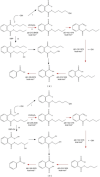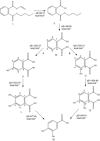Theoretical Design of Biodegradable Phthalic Acid Ester Derivatives in Marine and Freshwater Environments
- PMID: 33101830
- PMCID: PMC7570447
- DOI: 10.1002/open.202000093
Theoretical Design of Biodegradable Phthalic Acid Ester Derivatives in Marine and Freshwater Environments
Abstract
The biodegradability of phtalic acid esters in marine and freshwater environments was characterized by their binding free energy with corresponding degrading enzymes. According to comprehensive biodegradation effects weights, the binding free energy values were converted into dimensionless efficacy coefficient using ratio normalization method. Then, considering comprehensive dual biodegradation effects value and the structural parameters of PAEs in both marine and freshwater environments, a 3D-QSAR pharmacophore model was constructed, five PAE derivatives (DBP-COOH, DBP-CHO, DBP-OH, DINP-NH2, and DINP-NO2) were screened out based on their environmental friendliness, functionality and stability. The prediction of biodegradation effects on five PAE derivatives by biodegradation models in marine and freshwater environment increased by 15.90 %, 15.84 %, 27.21 %, 12.33 %, and 8.32 %, and 21.57 %, 15.21 %, 20.99 %, 15.10 %, and 9.74 %, respectively. By simulating the photodegradation path of the PAE derivative molecular, it was found that DBP-OH can generate .OH and provides free radicals for the photodegradation of microplastics in the environment.
Keywords: microplastics; molecular modification; pharmacophore models; photodegradation; ratio normalization method.
© 2020 The Authors. Published by Wiley-VCH GmbH.
Conflict of interest statement
The authors declare no conflict of interest.
Figures





Similar articles
-
A model for phthalic acid esters' biodegradability and biotoxicity multi-effect pharmacophore and its application in molecular modification.J Environ Sci Health A Tox Hazard Subst Environ Eng. 2021;56(3):361-378. doi: 10.1080/10934529.2021.1881352. Epub 2021 Feb 9. J Environ Sci Health A Tox Hazard Subst Environ Eng. 2021. PMID: 33563085
-
Efficacy coefficient method assisted quadruple-activities 3D-QSAR pharmacophore model for application in environmentally friendly PAE molecular modification.Environ Sci Pollut Res Int. 2020 Jul;27(19):24103-24114. doi: 10.1007/s11356-020-08725-0. Epub 2020 Apr 17. Environ Sci Pollut Res Int. 2020. PMID: 32301091
-
PAEs Derivatives' Design for Insulation: Integrated In-Silico Methods, Functional Assessment and Environmentally Friendly Molecular Modification.Int J Environ Res Public Health. 2022 Mar 9;19(6):3232. doi: 10.3390/ijerph19063232. Int J Environ Res Public Health. 2022. PMID: 35328919 Free PMC article.
-
Bacteria-driven phthalic acid ester biodegradation: Current status and emerging opportunities.Environ Int. 2021 Sep;154:106560. doi: 10.1016/j.envint.2021.106560. Epub 2021 Apr 15. Environ Int. 2021. PMID: 33866059 Review.
-
[Advances in biodegradation of phthalates esters].Sheng Wu Gong Cheng Xue Bao. 2019 Nov 25;35(11):2104-2120. doi: 10.13345/j.cjb.190177. Sheng Wu Gong Cheng Xue Bao. 2019. PMID: 31814358 Review. Chinese.
Cited by
-
Control Strategies of Plastic Biodegradation through Adjusting Additives Ratios Using In Silico Approaches Associated with Proportional Factorial Experimental Design.Int J Environ Res Public Health. 2022 May 6;19(9):5670. doi: 10.3390/ijerph19095670. Int J Environ Res Public Health. 2022. PMID: 35565062 Free PMC article.
-
Pollution caused by nanoplastics: adverse effects and mechanisms of interaction via molecular simulation.PeerJ. 2022 Jul 25;10:e13618. doi: 10.7717/peerj.13618. eCollection 2022. PeerJ. 2022. PMID: 35910776 Free PMC article. Review.
References
-
- Razanajatovo R. M., Ding J., Zhang S., Jiang H., Zou H., Mar. Pollut. Bull. 2018, 136, 516–523. - PubMed
-
- Wu Y., Guo P., Zhang X., Zhang Y., Xie S., Deng J., J. Hazard. Mater. 2019, 374, 219–227. - PubMed
-
- Ory N. C., Gallardo C., Lenz M., Thiel M., Environ. Pollut. 2018, 240, 566–573. - PubMed
-
- Courtene-Jones W., Quinn B., Gary S. F., Mogg A. O. M., Narayanaswamy B. E., Environ. Pollut. 2017, 231, 271–280. - PubMed
MeSH terms
Substances
LinkOut - more resources
Full Text Sources
Medical

